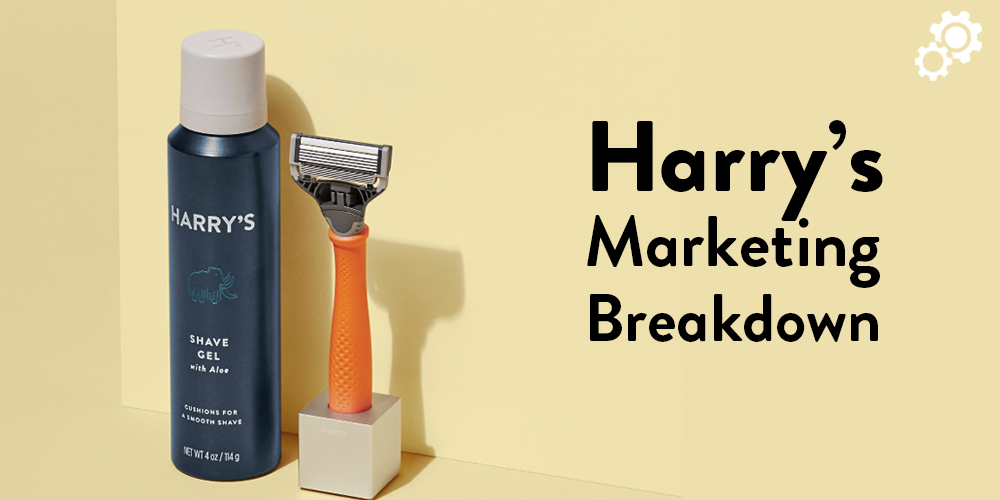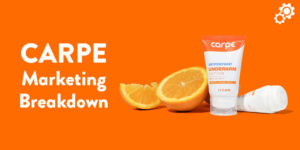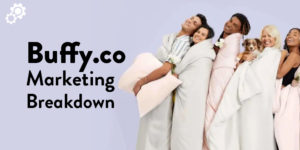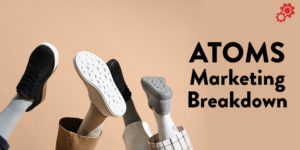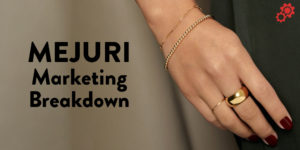I’m not much of a beard guy (only because I can’t grow one), but I love Harry’s.
As you’ll see in my breakdown, I came across Harry’s in 2017 when I was researching how to launch our new line of jump ropes and I’ve been pulling inspiration from them ever since.
Founded in 2013 by Jeff Raider and Andy Katz-Mayfield, Harry’s was up against a Goliath in the men’s razor space. It was the ultimate uphill climb against a mighty opponent. But through a combination of powerful storytelling, cheeky branding, and clever marketing strategies, Harry’s became a powerhouse.
In 2019, it was announced that Harry’s would be acquired by Edgewell for $1.37 billion. Although the deal fell through, it signaled just how high they climbed.
Let’s take a look at the marketing tactics that powered their rise.
Harry’s Marketing Tactics Overview:
- A fight against Big Razor (the power of storytelling)
- A recipe for a successful referral program
- The power of a loss leader (Harry’s Starter Set)
- Simple bridge pages for a more cohesive funnel
- AOV wins with mystery gift offers
Let’s get into the breakdown.
1. A fight against Big Razor (the power of storytelling)
We all love a good underdog story and Harry’s offers nothing short of that.
When they first entered the men’s grooming scene in 2013, Harry’s was up against a Goliath in the space – Gillette, aka Big Razor. In 2010, Big Razor (I love this name) was the dominant force, making up 70% of the global market share for razors. Not an easy hill to climb.
As it goes for many category leaders, this sort of domination gave Big Razor the ability to raise prices and generate sweet, sweet profits. And, with that, Harry’s found their in with a simple question:
“Why do razors cost so much? Like there’s no good real reason.”
– Jeff Raider, co-founder of Harry’s
Here’s a fun video of of how it all got started for them –
It’s a classic well-told tale of heroism that we all love to buy into.
Harry’s is here to save every man from an expensive shave by going direct to consumer (aka cutting out the middle man) and, in the process, offering a really great product at a very reasonable price. #win
In Storybrand, Don Miller talks about the importance of identifying (and naming) the villain in the story –
“In stories, a dastardly villain is a critical character. They’re the force that ultimately catalyzes our hero to take action and overcome the problem. And as the audience, we love a great villain. They deepen our love for the hero. They amplify the stakes of the story. They draw us in and keep us watching because we want to see our hero take the bad guy down. Your brand story needs a villain, too.“
Donald Miller, Storybrand
When you identify and name the Villain, you create a more compelling story, one that the audience (aka customers) are fully drawn into. And Harry’s did exactly that. They made us want to be part of the story and help take down the bad guy.
How does this manifest tactically?
Well, when you look around you’ll see the storyline play out at nearly every touch point. From the tagline that’s front and center on their site –
You deserve a great shave at a great price.
Harry’s tagline
To the ad copy they use:

To the landing page messaging:

To their email copy:

Every part of the journey – from the top of the funnel all the way to the bottom – builds on the underdog story and gets you to buy into something bigger than the brand. It makes you feel like you’re taking down a villain.
It also gets you to buy some razors.
Your key takeaways:
- Ask yourself: are we telling a story our customers can buy into or are we just selling a product?
- Revisit your company’s why (watch this video and this video) – why do you do what you do? Once you identify it, your why should serve as the backbone of your story. For Harry’s, their ‘why’ stems from the belief that men deserve a great shave at a great price.
- Think about how you are incorporating different story elements into your marketing. How are you framing. your customer as the hero? Who are you identifying as the villain? How are your positioning your brand as the guide? Storybrand has great tips for how to do this (here’s a quick intro doc).
2. A recipe for a successful referral program
You can’t talk about Harry’s without talking about their famous prelaunch campaign. That’s what put them on the map (at least for me).
“The idea for our campaign was built around our belief that the most powerful and effective way to be introduced to our new company was through a credible referral. Thus, we focused on building a campaign that helped people to spread the word to their friends.”
– Jeff on Tim’s blog
Back in 2017, we were looking for a way to launch our new line of jump ropes. After coming across a blog post on Tim Ferris’s site about how Harry’s collected 100,000 email addresses in one single week, I got so excited I had to test it out (like immediately).
While we didn’t have nearly the same level of success, a referral program can be very powerful and can be used in a few different ways.
“The fundamental mechanic of our campaign was a game: complete the challenge of referring friends and earn prizes.”
Jeff on Tim’s blog
But let’s briefly explain how it works first:
- Step 1: create a (very) simple landing page to capture a visitor’s email,
- Step 2: after they sign up, give them a reason to invite more people to the sign-up page.
That’s the game in a nutshell and the goal of the game is to collect as many (quality) email addresses as possible. Here’s how Harry’s did it –
Page 1 is a simple ‘Harry’s is coming’ landing page inviting visitors to be ‘the first to know’ –

Page 2 is where the magic happens. Harry’s asks their new subscribers to invite their friends to sign up too and, in exchange for doing so, they can earn points and get free Harry’s products.

You can see how powerful (and viral) this simple 2-step system can be.
While referral programs can work wonders for launching a product, that’s not the only place they can be used. We’ve used them to set up viral giveaways, online events (like challenges), and more.
Here are a few important things to remember:
- Objective – remember that the objective of this strategy is to generate (quality) leads so a great way to measure your progress is with number of new leads and cost per lead.
- Offer – everything boils down to the offer; your goal is to figure out what offer is compelling enough to make someone want to A) sign up for it, and B) share it (consistently) with their friends and family.
- Relevance – the offer needs to be relevant to the audience you’re targeting otherwise you’ll be building a list of people that may have no need or want for the product you will eventually try to sell them.
- Ease of signing up – although it differs from industry to industry, I find this 2-step system works best when friction is minimized. Signing up and sharing should be quick and frictionless. That’s why Harry’s only captured an email at the front end (while I’ve always liked capturing a name as well).
“Through the campaign, we wanted to encourage friends to tell friends, and those friends to tell their friends, and so on and so forth. Any barrier to sharing would hinder the campaign.”
– Jeff on Tim’s blog
When you’re putting together a campaign like this, it helps to have an initial push. You need something to help you build the snowball before you push it down the hill. The goal is to build up enough momentum at the outset so that the ball starts rolling and building on its own.
“Ahead of our launch, Andy and I spent a couple of months meeting friends, entrepreneurs and virtually anyone else who would listen to us talk about Harry’s. Whether or not they were interested in razors, we tried to interest them in our story. That list of people was probably a couple hundred long by our launch, and we created the campaign to help that group of people publicly share in the excitement of our launch.”
– Jeff on Tim’s blog
Here are a few simple ways to build that initial snowball:
- If you already have an email list, use it – invite your subscribers to join and participate in the program,
- Make a list of friends, family, colleagues, etc. and ask them to help you spread the word (that’s what Harry’s did) – try to build a small initial list of 100 or so people that can help you get the ball rolling,
- If you have the funds, drive some initial paid traffic to page 1 of your referral funnel.
We typically use a combination of the these to get the ball rolling.
Important reminder: generating leads successfully is only part one of the game. Part two is all about how you integrate that list into your email marketing program (and make it all pay off). We’ll save that story is for another day.
Your key takeaways:
- If you’re launching a new brand or product line, consider setting up a referral campaign to build an initial launch list and get potential customers spreading the word on your behalf.
- If you want a quick way to test if this would work for you, launch a giveaway. Think about what your target customer finds compelling and build a prize around it. Use tools like Viral Loops and King Sumo to set it up quickly – we’ve used both successfully.
3. The power of a loss leader (Harry’s Starter Set)
When I went to buy some razors from Harry’s for my important once-every-two-weeks shave, I noticed I kept getting directed to their Starter Set – a special offer just for me. No way!

While you won’t see it in their product catalogue, Harry’s makes a very concerted effort to acquire new customers through the Starter Set offer.
You’ll see it in their top of funnel ads, emails, paid search ads, etc.

But let’s zoom out for a minute. We all know about rising customer acquisition costs on paid social channels. I remember reading in Julian Shapiro’s growth marketing guide (must read, by the way) that it’s difficult to acquire a customer on Facebook or Instagram for less than $30USD.
“How much you earn per sale is critical. Consider how it’s hard to acquire an ecommerce customer for less than $30 USD on Facebook or Instagram, which are typically the cheapest ad channels. If you don’t earn at least that amount in the lifetime of a customer, these channels won’t be viable.”
– Julian from Julian.com
So if the average customer acquisition cost is roughly $30 USD (or higher) and Harry’s Starter Set is selling for $5 USD, simple math shows a (hefty) loss on that first order.
They call this a loss leader.
Loss leader pricing is a marketing strategy that involves selecting one or more retail products to be sold below cost – at a loss to the retailer – in order to get customers in the door.
Source: Shopify
To make this strategy work, you need to ensure your customer lifetime value is greater than what it cost you to acquire that customer. And Harry’s does this as good as anyone. There’s a video on Looker where former Director of Analytics Michael Kaminsky talks about the customer / subscription journey at Harry’s –

“We’re really interested in understanding how we can maximize the time between when the free trial starts and when that customers cancels their subscription.”
– Michael Kaminsky, former Director of Analytics @ Harry’s
Between multiple AOV bumps (see marketing strategy #5), a push for their CORE premium membership program before checkout, a convenient subscription model for refills, and a collection of other product offerings presented at the right times, Harry’s has all the tools in place to maximize CLV.
So why does it work? The magic behind this loss leader is two-fold –
For the customer – it makes the decision a very simple one. If I’m considering trying Harry’s, I don’t have to think about which shaving set to get. They tell me to get the Starter Set at nearly every touch point in my journey. More importantly, I don’t have to think about the price. At $5, it’s a no-brainer (well below the impulse purchase threshold and cheaper than any of the other offers I see in their catalogue).
For the brand – in regards to new customer acquisition, it allows them to be laser focused on optimizing one primary offer and streamlining all marketing efforts to capture a new customer.
Your key takeaways:
- You need to have a rough sense of your key numbers – what is your customer acquisition cost (CAC) for your primary marketing channel, what is your average order value (AOV), and what is your customer lifetime value (CLV). This will help you determine what type of offers you can test.
- Just because your AOV is less than your CAC, it doesn’t mean the marketing channel isn’t viable. It can work if you have the backend funnel to support it. Consider how you can increase your customer lifetime value with different product offerings, subscription services, etc. Read my breakdown on The Sill to see some clever CLV boosting tactics.
- Do you have a low cost product offering you can streamline all your marketing efforts through? If you do, it may be a worthwhile test – pay attention to conversion rate lift and make sure you have the backend to support the lower AOV on that first order.
4. Simple bridge pages for a more cohesive funnel
In my breakdown of Buffy’s marketing strategy, I talked about the the power of using (and testing) custom landing pages for your ads.
So let’s revisit those Harry’s ads I shared above (marketing tactic #2).
If you look at the landing page they drive their traffic to, it’s not to the homepage. They go to what I like to call the bridge page. Here’s what it looks like –

A bridge page is the page that lives between your ad and your product page. Since your ad is designed to capture attention and get a click, your bridge page helps educate the customer on your brand or product before they actually get to the product page.
So why direct traffic to a bridge page instead of directly to the primary offer page? A couple of reasons:
- Higher cohesiveness– it’s important to keep the copy and messaging on your ad cohesive with the landing page you drive traffic to. Since a new bridge page is built for every ad campaign, you can more easily ensure the journey is a highly cohesive one.
- Easier testing – while there’s not much to change on the Starter Set page, there’s plenty to test on the bridge page – different layouts, value propositions, elements, messaging, etc.
In Harry’s case (above), they’re using the bridge page to sell the difference – their why.
They know the customer is considering purchasing a Harry’s product for the very first time so it’s likely they are in research and comparison mode. They use the bridge page to explain why they are better than Big Razor.
Driving traffic to a bridge page may not always be the winning strategy and it depends on what type of ad you’re looking it. If your product requires a bit of education (unique value propositions, differentiators from popular competing brads, etc.), it may be worth testing bridge pages for your top of funnel prospecting ads.
If, on the other hand, your product and offer are simple and easy to understand, driving traffic directly to the offer page may be the better move.
Your key takeaways:
- Bridge pages can be effective landing pages for your ads and are worth testing.
- Be mindful of the cohesiveness between your ad and your bridge page – the bridge page should be an extension of your ad that continues the message and educates and excites the customer to make the next step in their shopping journey.
- Test different variations of your bridge page until you find a winning combination.
5. AOV bump with a mystery gift offer
I love this one because it’s so simple and clever. I feel more brands need to play around with mystery offers because they work on so many levels.
Here’s what happens when you go to review your order –

There are two things a mystery offer achieves:
- It bumps up AOV – curiosity gets the best of many customers and they need to find out what the hell the mystery box is (it worked on me). This increases average order value.
- It gets the customer to try the brand’s other product offerings – when I was purchasing my first razors from Harry’s, of course I ended up adding the mystery box. What did I get? Their face wash of course.
You can see the genius behind this.
First, you give your customer a little bit of a delightful moment with an opportunity to add a mystery item to their cart (something a little extra to look forward to). This increases AOV and feeds into the marketing calculus (see marketing tactic #3).
Second, you expose your customer to a new product line which increases their likelihood of purchasing that item later (if they like it), thus further incrasing up your customer lifetime value.
That’s pure gold right there.
Your key takeaways:
- Look for opportunities to surprise and delight your customers along their shopping journey. Where can you pique their curiosity? Where can you get them a little extra excited?
- If you have other product lines that you want to expose your customer to, consider introducing a ‘mystery’ offer as an order bump on their first order. The best place to start is with a low dollar offer that doesn’t feel like a stretch.
- If you don’t have other product lines to lean on, is there a small complementary accessory or relevant gift you can offer as a mystery order bump? Consider testing.
Harry’s Marketing Strategy Summary
When it was announced that Edgewell Personal Care Co. – which owns brands such as Schick and Wilkinson – would acquire Harry’s for $1.37 billion, it was exciting. It was to be one of the largest DTC acquisitions ever.
But it was also an interesting spin on our David vs Goliath story – as if little David grew up and decided to join forces with Goliath’s little brother. The FTC filed a lawsuit to block the acquisition saying the deal “would remove a critical disruptive rival that has driven down prices and spurred innovation in an industry that was previously dominated by two main suppliers, one of whom is the acquirer.”
Regardless, what’s clear as day is from a marketing standpoint, Harry’s figured it out.
They entered a scene dominated by big players and told a great story. They leveraged a myriad of unique and effective marketing tactics and built a brand worth over one billion dollars.
The marketing tactics I listed are the ones that stood out to me, but I encourage you to dig around and explore further – you’ll find all the amazing things they’re doing with promoting mental health care for men or their sleek online Magazine Five O’Clock or their #sharewithpride campaign.
Worst case, you’ll end up with a great shave at a great price.
Enjoyed this post? Sign up below to get notified when a new breakdown goes live –
✌
